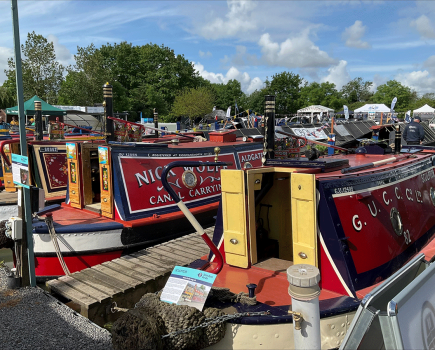As the investigations into the high-profile dam emergency get under way, we speak to the Canal & River Trust’s Head of Asset Management Julie Sharman about the possible causes and consequences of the failure

“Even if, despite the inspections, reports and recommendations, the worst were to occur, the situation could be handled…” So ended our 2017 article about the system for inspecting and maintaining the Canal & River Trust’s 72 reservoirs, after we had visited two reservoirs and seen first-hand the work in progress as a result of the ten-yearly statutory external examinations to ensure that ‘the worst’ didn’t occur.
But, as you will have seen from the TV and national press in recent weeks, at Toddbrook Reservoir above Whaley Bridge on the Peak Forest Canal, ‘the worst’ did indeed occur – if not in the form of a catastrophic dam failure, then at least in terms of a serious risk of collapse. Following exceptionally heavy rain, the reservoir overflowed – not just via the normal overflow spillway dating from the dam’s construction, but also via a rarely-needed emergency spillway added to the dam in 1971 to cope with abnormal conditions. But as the news reports showed, this resulted in serious damage to the concrete surface of the spillway structure, and the resulting danger of major failure of the dam led to an emergency evacuation of homes, pumping-out of the reservoir by fire services, and shoring-up of the damaged spillway with ballast delivered by RAF helicopter.
So what went wrong? Canal Boat spoke to Julie Sharman, the Canal & River Trust’s head of Asset Management with overall responsibility for the repair and maintenance of all the structures on the waterways system – including reservoirs and dams. Clearly it would be wrong to attempt to pre-empt the detailed investigations getting under way, but she immediately excluded one possibility. We are not talking about the spillweir being damaged by unanticipated flows as a result of extreme weather conditions going beyond what engineers have felt it necessary to cater for – and by implication, we shouldn’t blame climate change for it (although that’s not to say that engineers won’t have to give more consideration to coping with extremes in the future).
An important part of the final conclusions of the ten-yearly report (which in the case of Toddbrook was published in April 2019 following an inspection in November 2018) is to confirm whether the reservoir is capable of coping with a ‘once in 10,000 years’ flood event unscathed, and a ‘worst meteorologically possible’ event with only minor damage. CRT told us that the downpours at Toddbook leading up to the failure were nothing like that severe: a one in 50 years event followed by a one in 90. These are, in fact, exactly what the emergency spillweir was designed to cope with – and this is the first time it has needed to since 12 years ago, with the main spillweir being adequate the rest of the time.

So should it have been obvious (for example, from the vegetation growing on the spillweir surface which a number of commentators have mentioned) that it wasn’t being maintained in a fit state to do the job? Not according to the inspector who compiled the report. Yes, in its 100-plus pages there are many minor recommendations (as usual) but no immediate recommendations for any work on the spillway – and Julie Sharman said she was “absolutely confident” there was no indication that there was any risk that it might fail. Compare it to Barrowford Reservoir on the Leeds & Liverpool Canal (or to the two we reported on in 2017), where there were indeed some recommendations for work in the latest report, and water levels were held low while these were carried out.
Is the inspection regime adequate? Has it suffered from a dropping-off of maintenance standards due to shortage of funds? Julie points out (as did reservoir engineer David Brown on our 2017 visit) that dams are “the most regulated thing that we look after”, with statutory twice-yearly inspections by CRT (signed off by a member of the independent Panel) as well as the ten-yearly external one already mentioned (and signed off by the Secretary of State). It would literally be a criminal offence not to do this. On a more short-term level, a nominated CRT staff member visits twice per week, to look at it and check flows. And CRT says there has been no change to the system in 20 years.
Are CRT’s dams of a particularly unsafe type on account of their age? Sure, they’re older than most water supply dams (and their construction methods might well not be acceptable today), but there are 2,000-plus dams in England, and 80 to 90 percent are ‘earth dams’ of the same basic construction method based around a clay centre.
And yet it failed. It is now down to the CRT investigation (just getting under way) and the external one (currently being planned) to find out why. In the meantime the Environment Agency has written to all reservoir owners, all similar reservoirs are being looked at, and there may well be Government guidance issued in the coming weeks – but nothing has been found wrong with the basic design.
Also waiting on the completion of the investigations is any planning for repairs. Julie doesn’t think the Trust will even be in a position to begin rebuilding the dam for perhaps two to three years – and that means the combined summit level of the Peak Forest and Macclesfield canals will have lost one of its four reservoirs for at least a couple of summers. CRT’s Hydrology team is currently working on modelling the likely impact on these canals.
Yet another issue dependent on the results of the investigations is likely to be the cost of repairs – but it certainly won’t be cheap. There aren’t really any similar cases to compare it with, but to get a very rough ball-park figure the Ulley Dam in Rotherham (not a canal reservoir) which failed in 2007 cost £3.7m to put right. Add to that the costs of the initial emergency works, any costs passed on to CRT from the emergency services, the ongoing cost of maintaining it in its current state while planning the work and there could be a much bigger eventual bill, with perhaps £½m straight away. And while there’s always the possibility of external support, especially if there turns out to be a more general issue affecting other reservoirs, CRT will need to work on the basis of having to fund the repairs. Also there’s the distinct possibility of extra work needed at other similar reservoirs elsewhere. At least it will be possible to budget for the main work in advance, rather than having to cancel scheduled winter work, as happened following last year’s Middlewich breach.
Finally, we asked whether there was any local pressure not to rebuild the reservoir at all. Julie’s response was that there was a certain amount of understandable nervousness, rather than opposition, but that “we will absolutely need it”, that it’s listed as a Site of Special Scientific Interest for nature conservation and used by a sailing club – so it isn’t just canal boaters who have a use for it, and modern construction standards should make it “one of the safest in the country” when completed.
Image(s) provided by:
CRT







